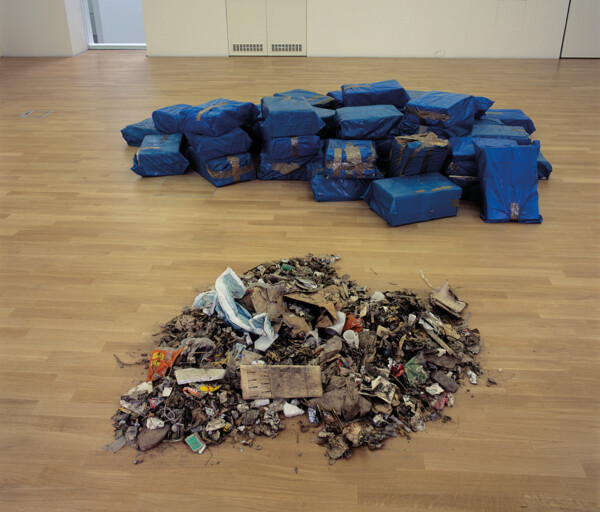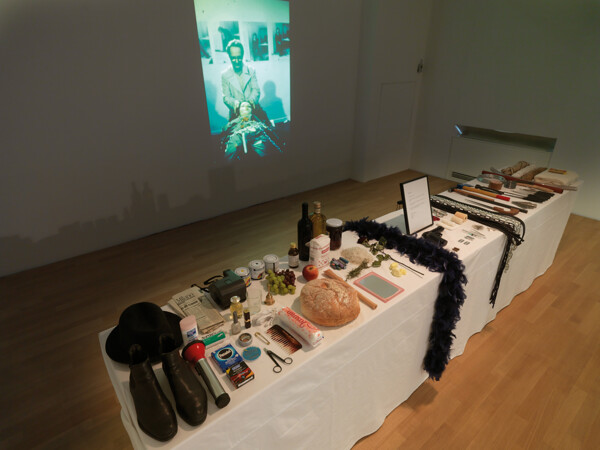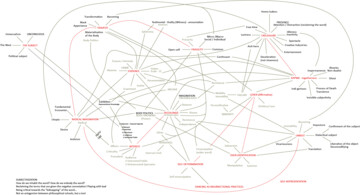What is radical imagination? Radical imagination is a process of “constructing something”, and this something has to do with procedures of subjectivisation. Radical imagination is not merely about the certain political potential of an artwork or its → emancipation from a representational regime, but about desire as the driving force of exploration, which surfaces at some fundamental encounter at the junction of politics, art, philosophy, or madness... and while doing so venturing into unknown territories, taking risks that could potentially lead towards something new (for example, breaking the habit). Imagination and desire are closely connected. Desire in a sense of being a mode of production and constructing of something (for example, a will to live, to create, to love, to invent another society, another value system).
Imagination already ceased to be the medium of knowledge very long ago, with the birth of modern science, and has merely become something excluded from real experience, a subject of “mental alienation” as Agamben put it. (In Antiquity the imagination was the supreme medium of knowledge, enabling in phantasy the union between the sensible form and the potential intellect. For example, the role dreams, visions and so on played and still play in some cultures.)
Which basically means institutionalised discourses and the authority of knowledge always take over the imagination – a history that is not yet. Of course, this take-over cannot be prevented but once we rethink art in a different way; not necessarily as representations, but rather as intensities or affects, where art has a performative rather than representational character – then there is a potential for possible new transversal alliances based on a different kind of “poetics of a political”.
But what kind of politics are we actually talking about?
In order to attempt to answer this question let’s go back a bit. Art, as we have learned through various narratives and concepts has to do with history. More importantly, art, as we know it through various forms, is already part of the past, and it is, to put it plainly, composed of the identifiable and formalised affects that become such through numerous encounters with different bodies, objects, ideas, institutions, etc. Both the State and the Institution fear the unknown affects, because these threaten the established order and, for that matter, anything that is fixed (identity), confined (aesthetics) and taken for granted (representation). But something, a force, always escapes this confinement, and that is where the encounters between art and “other bodies” should be investigated. Susan Buck-Morrs has proposed the idea of somatic knowledge[1], which she understands as a way the body senses reality in an animalistic or biological sense. For her, this kind of aesthetics is a → body’s form of critical cognition, a knowledge that can be trusted politically, because it cannot be instrumentalised. And if we think of art as a “bloc of affects and percepts”, then art is like an electrical shock, which always happens as “→ event” and only at “this” very moment.
Well, museums, of course, cannot “store” affects the way they store objects, but their task remains, nevertheless, to preserve all that which makes art, art. And art, as we already know, is made of affects. On the other hand, a museum itself is an affective body too, which to some extent defines and “orchestrates” other bodies (things, objects, ideas, other affects, and the like).

Figure 1: Tomislav Gotovac, Cleaning Public Spaces, installation, mixed materials, 1981. Courtesy of Moderna galerija, Ljubljana.

Figure 2: Marina Abramović, Rhythm 0, installation, 1974. Courtesy of Moderna galerija, Ljubljana.
However, there is a difference in the way bodies were affected, for example by Tomislav Gotovac, when he cleaned the streets of Zagreb in 1981, and by the → residue of that event, a pile of garbage, now in the 2000+ Arteast collection of MG (Figure 1); or another event from the same year, where Gotovac walked naked in downtown Zagreb. This event was an unmediated experience, but only until its affects were recognised as “signifying gestures”, perceived as a threat to the order of the State (after seven minutes Gotovac was arrested by the police). Now, what are the prospects of affects in the “zone” of a museum? A museum, like any Institution, attempts to prevent the appearance of uncontrolled affects. There are, however, exceptions. Well-known is the performance Rhythm 0 by Marina Abramović from 1974, where she “offered” herself to the public in a gallery as a passive object, and during which the visitors could do anything they wanted to her. Abramović purposely exceeded her power of being affected to such an extreme that after the performance was over, and she became a subject again, the public could not bear to face the artist any longer, and literally ran away from her and the gallery premises. What happened was that the “threshold of intensity” had been crossed, and subsequently a difficult encounter transpired. (Figure 2)
So what is the connection between affects and politics in the context of a museum? How do museums deal with the “limits of being affected”, and what do these excesses produce, what kinds of subjectivities are constructed with these encounters?
I will talk a bit about a project/method/encounter called Radical Education (RE) that happened in relation to/with Moderna galerija from 2006 on. The people involved in this process came from various domains: political activism, migrant movements, anarchism, art, anthropology etc. There were many debates from the start, for example about participatory-multicultural projects, because, for one, we did not want RE to be understood as a kind of participatory project within an art institution, or as part of the prevailing multicultural paradigm. Our opinion was that such temporary → solidarities (→ solidarities), such identifications between minorities, marginalised and other groups – “the projections of politics as other and outside – only detract from a politics of here and now”. The idea was to create a contact surface between social movements and the art institution, and to invent new institutional forms of → resistance, new political subjectivities, new affective excesses, so to speak.
But more important than creating a space within the space of an art institution was the involvement with certain materials of expression, with groups and individuals, and always with an outside to open up a new universe of reference. This meant that we began to ask what, why and how is it that my body agrees with the other affective body? Or put another way, what can my body actually do, what is it that is → common in my body and another body, what is the “meaning” of the encounter, for example between an art institution and a social centre?
One of the aims of RE was to define common investigations between the two fields, art and politics, and to ascertain, through concepts such as power, work, labour, aesthetic experience, affects and other subjective components embedded in the work processes and the work itself, and so on, what is it that art forms and forms of political resistance have in common? For example, a question that we found very important and around which we organised a series of seminars, “Resistance as Creation”, together with → migrant workers, political activists and cultural workers in the Ljubljana social centre, was: What is creation, what is radical imagination? Not only from the perspective of artwork, but also from that of the production process being an aesthetic experience itself. Is manual work as such an aesthetic experience? What about art which repeats → labour? Is this experience limited only to the spaces of art museums, or can it spread everywhere? Is it a collective creation by the artist becoming a collective worker or a → representation made by an individual? Can art function as a tool of political → emancipation? It is important to emphasise that RE’s goal was not only to compose a meaningful and relevant set of questions, but, above all, to implement and confront those questions in collective situations, to democratise expert knowledge and to produce common knowledge instead. Under the term “common knowledge” we understood a form of theoretical thinking accompanied by politically active attitudes, to test its social effectiveness and enhance the support and strategies to common areas of conflict.

Figure 3: Minna Henriksson, “Ljubljana Notes”, 2008, a part of Politicisation of Friendship, Museum of Contemporary Art Metelkova, +MSUM, 1 July 2014 – 5 October 2014. Courtesy of Moderna galerija, Ljubljana.
Recently, madness has been one of the domains within the exhibition Politicisation of → Friendship held at the Moderna galerija, where madness transversed art and politics. (Figure 3) Similarly, as with RE before and based on the same points of departure, madness, or more precisely the anti-psychiatric movement from the 1980s, entered the space of an art institution (that is – Moderna galerija). Madness was here understood as something that creates paradox within an institution, madness as thinking that discomforts, all the while escaping control, stretching the limits of the affective excesses of an institution. People from the movement told us: it is not about problematising madness as such, but society’s attitude towards it. Madness is one of the creative principles and a driving source, and it should be protected as such. Collective by nature, it becomes tragic when a person is stranded alone with it.
We have learned from RE that what art and social movements, and lately anti-psychiatric movements, have in common is not their content, such as the views of art on social resistance. It is also not the assumption that the site of artistic transformation can also be the site of political and social transformation. It is rather the questions of how to not be separated from our power of acting, and how to produce adequate ideas, which concern not only individual forces, but also collective bodies forming common notions or common relations between bodies. For example, if there is a resonance between art and “resistant corporealities” then art can eventually become a resource for revolution. At their most powerful, at the point of conversion, these kinds of resonances can become so “overwhelming and bodily that they defy representation”.[2]



